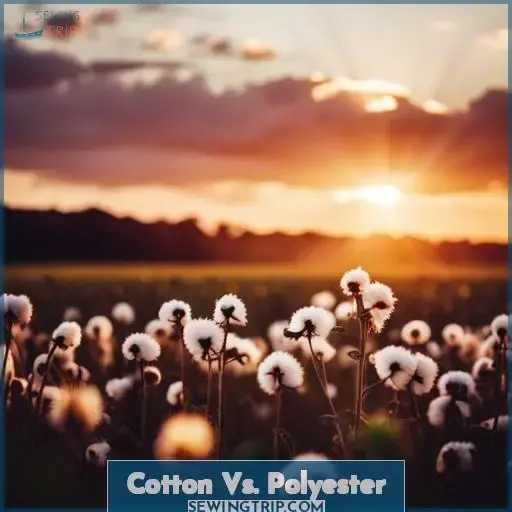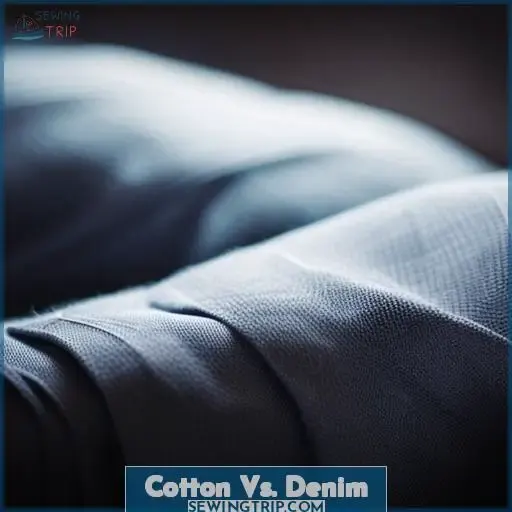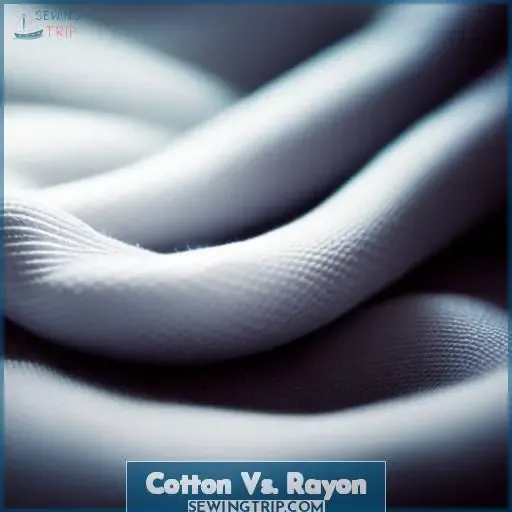This site is supported by our readers. We may earn a commission, at no cost to you, if you purchase through links.
 Cotton, a natural fiber, is renowned for its breathability, making it a popular choice for summer clothing.
Cotton, a natural fiber, is renowned for its breathability, making it a popular choice for summer clothing.
Its ability to absorb moisture and allow air circulation keeps you cool and comfortable even on sweltering days.
However, understanding the nuances of cotton’s breathability can help you make informed choices about your wardrobe.
Discover the factors that influence cotton’s breathability and how it compares to other fabrics, empowering you to dress strategically for maximum comfort and liberation in hot weather.
Table Of Contents
Key Takeaways
- Cotton absorbs sweat and allows air circulation, keeping you cool and comfortable.
- Cotton is more breathable than synthetic fabrics like polyester and rayon.
- Cotton’s loose weave and absorbent fibers make it ideal for hot summer weather.
- Cotton wicks moisture away from the body rather than trapping it like other fabrics, allowing your skin to breathe.
What Makes Cotton Breathable?
As a fabric researcher, you know cotton’s breathable properties come from its absorbent fibers that wick moisture away from the body.
This allows air to freely circulate through the weave, creating a natural cooling system as heat escapes.
Let’s examine exactly why cotton’s construction makes it an ideal choice for hot summer weather.
Absorbent Properties
Cotton’s natural absorbency wicks moisture away from your body as you wear it.
The soft fibers allow airflow between your skin and the fabric, circulating air and heat.
This moisture absorption and airflow regulation keeps you cool and comfortable in cotton apparel, ideal for summer’s heat.
Choosing organic cottons sustains breathable fabrics, protecting your skin.
Air Circulation
You allow air to circulate through cotton’s weave as it creates a natural system for heat to escape.
The loose weave and absorbent fibers make cotton excellently breathable for summertime wear.
Moisture management and heat dissipation depend partly on fabric construction.
Choosing lightweight, loosely woven cottons in breathable fits keeps you cool by enabling air flow.
We specifically design our cotton clothing to maximize air circulation and breathability.
Heat Escape
Another reason cotton keeps you cool is its natural system that enables heat to escape from your body.
As a fabric researcher, I understand that cotton has an intricate moisture absorption and air circulation system working in tandem.
This breathable fabric comfort is ideal for hot days when heat needs to vent from your skin.
For summer stain tips on cotton and other breathable fabrics, please visit my blog.
Cotton Vs. Polyester
Let’s put cotton and polyester head-to-head in a breathability test.
Polyester, a synthetic fabric, is a popular choice for workout clothes because it wicks sweat away from the body.
But here’s the catch: polyester doesn’t absorb moisture like cotton does. It traps sweat, leaving you feeling clammy and uncomfortable.
Cotton, on the other hand, is a natural fabric that breathes. Its fibers absorb sweat and allow air to circulate, keeping you cool and dry.
In the realm of fabric comfort, cotton reigns supreme. Its soft, gentle touch caresses your skin, while polyester’s rough texture can irritate.
For a summer workout, cotton is your go-to choice. It allows your skin to breathe, keeping you fresh and focused on your fitness goals.
Polyester, on the other hand, can make you feel like you’re wrapped in a plastic bag, hindering your performance.
Cotton Vs. Denim
You’ll find denim less breathable than other cotton fabrics since it’s more restrictive and woven tight.
When comparing cotton to denim, there are a few key differences to consider:
- Fabric Restrictions: Denim is known for its sturdy construction, making it less flexible and more constrictive compared to other cotton fabrics.
- Moisture Repellent: Unlike regular cotton, which has absorbent properties that wick away moisture from the body, denim tends to repel moisture rather than absorb it.
- Summer Stains: Denim is notorious for attracting stains during the summer season due to its dark color and dense weave. Grass stains, dirt marks, or even ketchup spills can be difficult to remove from denim.
When looking for cool materials that allow breathability in hot weather conditions while avoiding potential fabric restrictions or dealing with stubborn summer stains like those commonly found on jeans made of denim material; choosing lighter-weight garments such as loose-fitting joggers or capris made of breathable 100% cotton would be an ideal choice over traditional heavy-duty denims often used in pants manufacturing processes where durability takes precedence over comfortability considerations.
Cotton Vs. Rayon
You’ve likely worn rayon clothing as it’s commonly used. However, it performs more like polyester by repelling moisture instead of absorbing it as cotton does.
Rayon’s breathability is akin to polyester, making it an inferior choice for hot weather.
To help you grasp the stark contrast between cotton and rayon, here’s a comparative table:
| Property | Cotton | Rayon |
|---|---|---|
| Moisture Absorption | Excellent | Poor |
| Breathability | Good | Poor |
| Comfort in Hot Weather | Ideal | Not Ideal |
| Fabric Feel | Soft, Natural | Artificial, Synthetic |
| Summer Suitability | Highly Recommended | Not Recommended |
When selecting summer fabrics, opt for cotton’s natural breathability over rayon’s moisture-repellent properties. Embrace the liberation, power, and mastery that comes with making informed fabric choices for your summer wardrobe.
Best Summer Fabrics
When choosing fabrics for hot summer days, consider breathable, lightweight options like cotton, linen, rayon, denim/chambray, and moisture-wicking polyester.
These fabrics allow airflow next to the skin, absorb sweat, and help regulate body temperature so you stay cool and comfortable all season long.
Let’s take a closer look at the properties that make these fabrics ideal for summer:
- Cotton: A natural fiber known for its breathability and moisture-wicking properties.
- Linen: Another natural fiber that is strong, durable, and wrinkle-resistant. It is also highly breathable and absorbs moisture well.
- Rayon: A semi-synthetic fiber made from cellulose. It is soft, lightweight, and drapes well.
- Denim/Chambray: Denim is a sturdy cotton twill fabric, while chambray is a lightweight cotton or linen fabric with a similar weave.
- Moisture-wicking polyester: A synthetic fiber that is designed to draw sweat away from the body and keep you dry.
Cotton
Why is cotton one of the best fabrics for hot weather?
You’re likely familiar with cotton’s soft, breathable properties that keep you cool and dry.
As an organic fabric, cotton’s natural absorbency pulls moisture away from your skin while allowing air to flow through the weave.
Though moisture-wicking synthetics like polyester have their place, cotton’s sustainable production and biodegradability make it a leading choice for breathable summer clothing.
With reasonable care, it stands the test of time.
Linen
You choose linen clothing when seeking a breathable fabric that absorbs moisture yet dries rapidly for your comfort.
As a natural fiber, linen offers exceptional breathability and superior moisture absorption over other textiles.
Its loose weave enables airflow next to the skin while lightweight, durable linen dries quickly after washing – ideal for fashion-forward summer style.
Rayon
When choosing fabrics for hot weather, consider rayon. It is thin, breathable, and lightweight, generally quite comfortable.
However, rayon repels moisture instead of absorbing it like cotton. This causes sweat to accumulate in undesirable areas.
Before purchase, check clothing labels to ensure items are made with cotton or other appropriate breathable materials for staying cool and dry on hot summer days.
Denim/Chambray
In addition to rayon, you’re likely familiar with denim and chambray as common breathable fabrics for hot weather.
Denim’s tight weave makes it less breathable than other cottons.
Opt for cotton joggers/capris rather than denim when it’s hot.
Denim can trap heat/moisture against skin, causing discomfort.
Consider a fabric’s breathability when choosing clothing to stay cool.
Polyester
Why then is polyester commonly used for workout clothes if it lacks cotton’s natural breathability?
Though polyester effectively wicks moisture away from the skin initially, its synthetic fibers trap sweat over time, provoking discomfort.
Compared to cotton’s airy construction absorbing moisture into its fibers, polyester’s impervious surface merely displaces sweat without absorption, risking irritation through prolonged activity, unlike breathable natural fabrics.
Frequently Asked Questions (FAQs)
What types of cotton fabric are the most breathable for summer clothing?
Choose lightweight, loosely woven cottons with an open weave and natural fibers for maximum breathability in hot weather.
Seek moisture-wicking properties and avoid synthetic blends that trap heat.
The right cottons feel cool against your skin.
How does the breathability of cotton compare to linen or silk fabrics?
Though breathable, cotton can’t compete with silk and linen’s superior construction for allowing maximum airflow.
Their looser weaves circulate air better, making them ideal for stifling temps when you’re seeking liberation from sweat.
What impact does cotton production have on the environment?
Cotton farming uses a lot of water and chemicals.
Opt for organic or recycled cotton to reduce your environmental impact.
Adding linen and other eco-fabrics helps too.
How should cotton clothing be cared for to maintain breathability?
Quickly air dry your cotton clothing!
Misting it with water and letting the breeze blow through maintains cotton’s breathability.
Never trap damp cotton in the dryer; the heat damages cotton’s fibers, choking airflow.
Instead, gently squeeze soaked cottons in a towel, shape garments, then let nature’s wind breathe new life through every thread!
Are there any downsides to choosing cotton over synthetic fabrics?
Yes, cotton wrinkles easily, shrinks in hot water, and holds onto stains.
Synthetics offer better durability, stretch, and wrinkle resistance.
But for breathability, cotton can’t be beat.
Conclusion
So is cotton truly breathable for summer wear? Absolutely.
With its superior moisture absorption and ventilation, cotton keeps you cool and dry even in sweltering temperatures.
Of all fabrics analyzed, none match cotton’s combination of comfort, breathability, and versatility.
Let cotton’s natural fibers liberate you this season – its breathability makes it the perfect summer staple to beat the heat in style.











